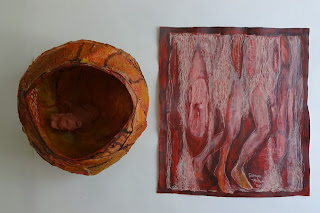 Provocations
ProvocationsThe difference between the formal aspects of our work is vast. You derive your sources from European canons and the Roman city were you grew up. I like to think about my work about something unclassified and uncollectible. Examining our polarities is obvious; less evident and surprising is to identify the dialogue among our work.
Through the years our works have hanged across each other in our living and working space. They seem to understand each other; for example looking at your still lifes from the turn of the century is evident the tension between the three dimensional object and the flat surface and background were those objects are placed. It seems like the interplay between you and me. It is in those boundaries were we find each other, beneath the subject, the technique, or the form, it is in our intentionality that we engage and find each other.
The relationship between two artists behind the studio door is invisible to the audience gaze, but I am convinced that our work is possible because of our relationship and vice versa. As we create through years of togetherness and knowing what we wanted to achieve and how our interaction affect our process and subject matter.
Our first years were tumultuous as our mutual admiration did not stop the harsh criticism among us. I resented your Western art history background, you disliked my favorite artists. We gave each other our own art work as treasured gifts; you went through my garbage to rescue those works I created and then discarted.
We would go to museums and passionately discuss the merits of a piece of art and the state of contemporary art.
Inspiration and ideas also came with our interaction as we took photographs or practice printmaking together. After a few years, we argue about art less and we learned to communicate with less words. Last week, in the "Van Gogh and Expressionism" exhibition at the Neue Gallery we already knew we will love Vincent and Klimt, we also knew that at some point you will make some comments about the German artists and I will overreact for a few seconds but it will not matter because later on we will be mesmerized by a new art work we had never seen before and we will agree about that piece of Egon Schiele. Then we will leave the museum enchanted, in love and knowing that images are stronger than words.
Art work: Daniel Montoya. Oil on wood. 2001

Comments